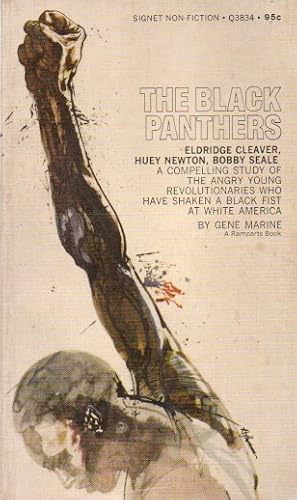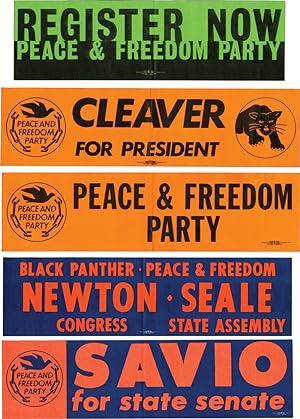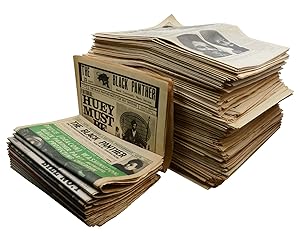cleaver eldridge newton huey seale (4 risultati)
Tipo di articolo
- Tutti gli articoli
- Libri (4)
- Riviste e Giornali
- Fumetti
- Spartiti
- Arte, Stampe e Poster
- Fotografie
- Mappe
-
Manoscritti e
Collezionismo cartaceo
Condizioni
- Tutte
- Nuovi
- Antichi o usati
Legatura
- Tutte
- Rilegato
- Brossura (2)
Ulteriori caratteristiche
- Prima edizione (2)
- Copia autografata
- Sovraccoperta
- Con foto (3)
- No print on demand
Paese del venditore
Valutazione venditore
-
The Black Panthers
Editore: Signet, New York, 1969
Da: San Francisco Book Company, Paris, Francia
Prima edizione
Pocketbook. Condizione: Good. Pocketbook. wraps, 224 pp, b&w photos, first printing, tape marks to photos, spine creased Standard shipping (no tracking) / Priority (with tracking) / Custom quote for large or heavy orders.
-
Paperback. 4th. 3834 very good -fine, corner crease paperback,
-
Five original Black Panther / Peace and Freedom Party oversize bumper stickers
Editore: Berkley Graphics Arts, Berkeley, 1968
Da: Royal Books, Inc., ABAA, Baltimore, MD, U.S.A.
Collection of five vintage bumper stickers from the 1968 political campaigns run via a collaboration between the Black Panthers and the Peace and Freedom Party. Each of the stickers were made for various Peace and Freedom Party political campaigns, including: Mario Savio for California state senator, Black Panther founders Huey Newton and Bobby Seale, and Eldridge Cleaver for president, and two stickers simply advertising the Peace and Freedom Party itself. In 1968 the Black Panthers would move away from direct actions (including their legendary confrontations with the Berkeley police department) and briefly into the political sphere, when they joined forces with the PFP, a left-wing anti-war party advocating Black liberation, women's liberation, and LGBTQ rights. The campaigns were largely seen as political statements, as Cleaver was a convicted felon and technically ineligible for the presidency due to his being under the age of 35 by the time of inauguration, and as Newton and Seale were on trial at the time, repeatedly being denied their civil liberties. All items rare, each with original peel-off paper backing, and each between 4 x 13.5 an 4 x 15 inches. Near Fine and unused, with light soil on two of the stickers and rubber stamp for the "Lancaster County Peace & Freedom Movement Organizing Committee" on the verso of one sticker. A few of these rear peel-off panels have come loose due to dryness, but most are intact, and the bumper stickers themselves are unaffected.
-
The Black Panther: Black Community News Service (Collection of 233 issues, 1967-1980)
Editore: The Black Panther Party, Oakland & San Francisco, 1980
Da: Burnside Rare Books, ABAA, Portland, OR, U.S.A.
Prima edizione
First edition. An extensive collection of 236 numbers in 233 issues (Volume 2, Numbers 15-17 are printed in a single volume and Volume 6, Numbers 13 and 14 are as well). Intermittent run spanning from the first volume to the final volume (the 20th). Newspaper changed title to The Black Panther Intercommunal News Service on March 13, 1971.Contents: Volume 1, Number 6; Vol. 2, Nos. 1-3, 5-7, (15-17), 18, 19, 21; Vol. 3, Nos. 1, 3, 6, 7, 9-12, 16, 17, 19-21, 26, 27, 29, 29 [sic], 31; Vol. 4, Nos. 3, 3 [sic], 4, 7, 8, 8 [sic], 9, 12-15, 17, 18, 18 [but 19], 20, 21, 22, 22 [sic], 27, 28, 28 [sic], 29; Vol. 5, Nos. 4, 12, 13, 15-18, 20-25, 27, 30; Vol. 6, Nos. 1-6, 10, 11, (13-14), 16, 18, 21, 23-30; Vol. 7, Nos. 1, 3, 8, 19-27, 29, 30; Vol. 8, Nos. 1-25, 28-30; Vol. 9, Nos. 1, 3-8, 10, 12-15; Vol.10, Nos. 15, 18, 23, 25, 27, 28, 30; Vol. 11, Nos. 12, 14, 15, 21, 23, 26, 29; Vol. 12, Nos. 1, 7, 12, 15, 16, 30; Vol. 13, Nos. 2, 7, 11, 12, 19, 20, 21, 29, 30; Vol. 14, Nos. 4, 8, 11-13, 15, 17, 18, 28; Vol. 15, Nos. 3, 10-15, 26-30, 30 [sic]; Vol.16, Nos. 4, 5, 8-11, 13, 18, 27-30; Vol. 17, No. 29; Vol. 18, Nos. 1, 3-9, 11, 16-19, 22-26, 28, 29, 29 [sic]; Vols. 19, Nos. 3, 5-7, 7 [sic], 8, 9; Vol. 20, Nos. 1, 3; Extra, Saturday, October 5th, 1968 [Unnumbered]. A well-preserved and very substantial run of the Black Panther Party's official newspaper, with the issues representing a large swath of the paper's content, circulation, and overall aesthetic. In terms of content, Huey Newton was acknowledged as the chief theoretician of the Party and its newspaper, though in terms of generating mass-appeal, much of the credit goes to Emory Douglas: "Douglas's work on the Black Panther newspaper and for the party was fearless in content and style. He was the party's Revolutionary Artist, graphic designer, illustrator, political cartoonist, and the master craftsman of its visual identity. His distinctive illustrations styles, cartooning skills, and resourceful collage and image recycling made the paper as explosive visually as it was verbally.Part of Douglas's genius was that he used the visually seductive methods of advertising and subverted them into weapons of the revolution. His images served two purposes: to illustrate conditions that made revolution a reasonable response and to construct a visual mythology of power for people who felt powerless and victimized" (Durant, Sam (ed). Black Panther: The Revolutionary Art of Emory Douglas, pp.95-96).Contains an over-arching glimpse of the art, layout, production and content of the newspaper as well as the rise and fall of the Black Panther Party, with issues ranging from the earliest days through 1980. Visually stunning and innovative in its design and layout, they tell the story of the Black Panthers' struggle fighting racism and institutional violence and oppression. A key publication responsible for shaping African American revolutionary thought in the twentieth century; runs this extensive are very uncommon in commerce.





